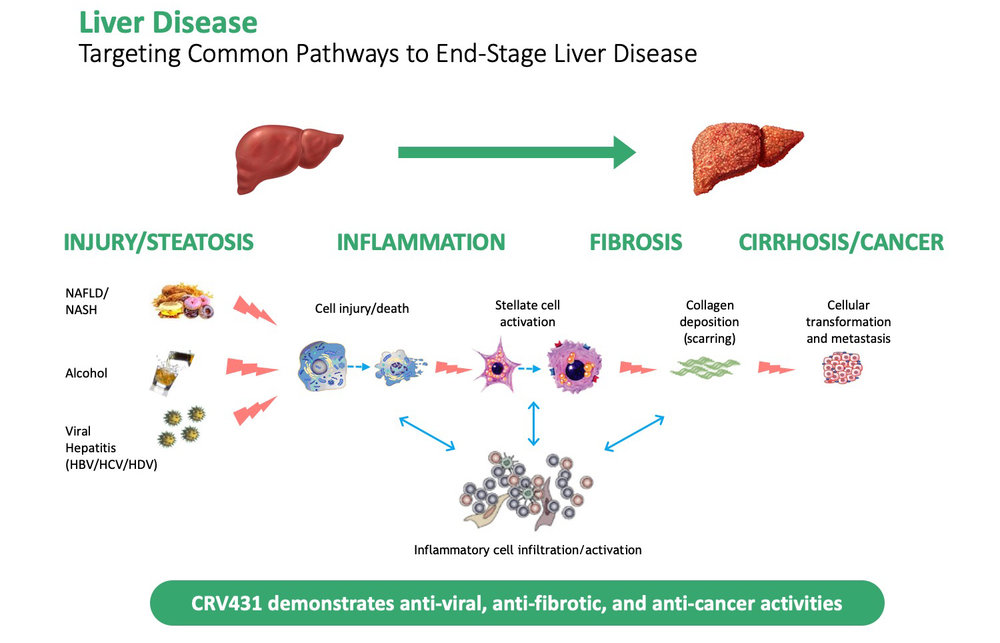
Hepion Pharmaceuticals (NASDAQ:HEPA), which recently changed its name from ContraVir Pharmaceuticals, is developing targeted therapies for liver disease arising from non-alcoholic steatohepatitis (NASH) and chronic hepatitis virus infection (HBV, HCV, HDV). The company is currently testing its lead drug candidate, CRV431, in Phase 1 trials for HBV, and recently received the FDA’s authorization to commence an IND opening study for the treatment of NASH, which complements Hepion’s current IND for the HBV indication. In this interview with BioTuesdays, Dr. Robert Foster discusses NASH, data the company has generated to-date, and its clinical development plans for CRV431.
What is NASH?
NASH is the more severe form of non-alcoholic fatty liver disease, or NAFLD. NAFLD and NASH are major contributors to the development of significant liver disease. Other contributors include alcohol consumption and viral hepatitis. Any of these factors can trigger a series of events that can lead to end-stage liver disease and liver failure, which may be life threatening.
NASH patients typically have fatty livers with inflammation and ballooning – or liver cell degeneration, and fibrosis – or scarring, which results from the deposition of collagens and other molecules into a stiff matrix outside of cells. The amount of fibrosis is the major determinant of disease progression to cirrhosis and hepatocellular carcinoma, the most common form of liver cancer, of which NASH is a leading cause.

Why has this indication been gaining attention?
NASH has been gaining attention because of the rising prevalence of fatty liver disease. Approximately 1-in-4 individuals globally have fatty liver disease, and an estimated 3-5% of the world’s population has NASH.
So, I think more companies are interested in this indication because a treatment could generate life-saving therapies and also create real value for all stakeholders. The fact that there are currently no approved treatments for NASH is driving further interest in this indication, and it is expected that NASH will become the primary reason for liver transplants.
Have improved diagnostics contributed to the interest?
To some degree, yes, as our ability to diagnose NASH has improved, but it’s not nearly as much of a driver as the global epidemic of NAFLD.
Historically, the only way to confirm the presence of NASH was by liver biopsy, and that method is less than perfect. So, the availability of more tools enables less invasive and more accurate diagnoses. These include more sophisticated imaging, series of blood tests and lab panels, and transcriptome and metabolome profiling. These tools are especially important as a large portion of individuals who have NAFLD aren’t aware of it. A common misconception is that NAFLD only occurs in significantly overweight or obese individuals, but there is what is referred to as “lean NASH,” where the disease presents in seemingly healthy individuals.
What is CRV431?
CRV431 is an orally administered cyclophilin inhibitor that we believe will be administered once daily. Cyclophilins are enzymes that catalyze protein folding processes that are important for the three-dimensional configuration of proteins, and in turn, their function. Specifically, cyclophilins regulate folding at one unique protein building block, the amino acid, proline. Many disease processes are characterized by an overproduction of proteins, and therefore disrupting the production of properly folded proteins with CRV431 is one strategy for treating disease.
CRV431 is based on the scaffold of cyclosporine, an immunosuppressive drug that also binds cyclophilins. The major difference between these molecules is that the binding of cyclosporine to calcineurin has been chemically removed in CRV431, so it does not have the immunosuppressive properties of cyclosporine. The cyclosporine scaffold of CRV431 however, has been chemically modified to enhance binding to cyclophilins. These novel chemical modifications are what confer the properties of CRV431, and since cyclosporine has been used commercially in North America since 1983, for a variety of indications, we don’t anticipate any safety issues with CRV431.
How does CRV431 work to reduce fibrosis?
Collagen is the most abundant protein in fibrotic scars, and proline is extremely abundant in collagen. By targeting proline, cyclophilins play a major role in both the amount of collagen produced and the formation of its intricate helical and crosslinked conformations. Therefore, the evidence is quite compelling that CRV431 can reduce fibrosis by blocking the roles of cyclophilins in collagen production and folding.
Additionally, experiments from our laboratory indicate that CRV431 can also change the expression of many genes that contribute to fibrosis. These genes include not only collagen and other building block molecules, but also other enzymes (e.g. lysyl oxidases) that help to construct the fibrotic matrix. Experiments are ongoing to try to understand this second important mode of action of CRV431.
How does CRV431 work as an antiviral?
Many viruses, including HBV and HCV, have “learned” to take advantage of cyclophilins to help them to replicate and evade the immune system. Certain viral proteins bind to cyclophilins to help them fold and function in ways that benefit the viruses. One example is the HBV surface antigen protein, HBsAg, which is produced in extreme quantities by HBV and seems to protect the virus from the immune system. CRV431 blocks the binding of cyclophilin A to HBsAg, which leads to lower HBsAg production in experimental models. It would be exciting to see a similar effect in human HBV patients, as current antiviral treatments largely do not affect HBsAg concentrations in the blood.
Interestingly, CRV431 can also exert anti-HBV activity independent of cyclophilin inhibition by binding directly to a protein called NTCP on the surface of liver cells that acts as an HBV receptor. Therefore, CRV431 has the potential to reduce new infection and re-infection of liver cells by HBV.
Hepion was originally targeting HBV with CRV431. What led to the expansion to the NASH indication?
The ultimate goal of antiviral drug development is to completely eradicate viruses from patients and restore antiviral immunity. However, achieving such a “sterilizing cure” for HBV infection is very complex due to the nature of this very stealthy virus. Commercialized drugs that reduce HBV viremia already exist, but they rarely lead to complete elimination of the virus. CRV431 has shown anti-HBV effects in many experimental models, so it has potential to improve upon existing treatments. Achieving a sterilizing cure still remains a very lofty goal, and one that will be very challenging.
Based on our own experiments on CRV431 and on the scientific knowledge of cyclophilins’ role in HBV infection and fibrosis, we concluded that the likelihood that CRV431 could impact fibrosis, inflammation, and other related disease processes was greater than its complete eradication of HBV. The high prevalence of fibrosis as a disease process means that CRV431 might also hold potential in lung, heart, kidney, or other organ disorders where fibrosis plays a role. The increasing prevalence of NASH was also a contributing factor in our decision to focus on CRV431 as an antifibrotic.
Approximately 250 million people worldwide are chronically infected with HBV, and the risk of developing liver fibrosis and cancer in these individuals remains a significant problem. When fatty liver disease and NASH are overlaid upon the HBV population, the diversity of mechanisms through which CRV431 could benefit patients becomes even greater. Our data generated thus far point to CRV431’s antifibrotic effects as translating to the greatest possible therapeutic and commercial success.
What data has Hepion generated for CRV431 in NASH?
We originally used a STAM NASH mouse model to test CRV431’s ability to decrease NAFLD scores, which consider the extent of inflammation, steatosis and ballooning. We found that treatment with CRV431 earlier in the disease course decreased NAFLD scores. This seems to indicate to us that CRV431, given early, may alter the steatohepatitis, ballooning, and inflammation of the liver. However, the results we saw with fibrosis were even more exciting.
To explore CRV431’s impact on fibrosis, we conducted four separate and independent studies in the same NASH model. We quantified the amount of collagen after treatment with CRV431 and consistently saw a statistically significant decrease in the amount of fibrotic scarring. And, the antifibrotic activity we observed appeared to be quite potent, even when we compared CRV431 to other late clinical stage compounds.
Tell us about the data you collected from two new NASH models.
After we determined that CRV431 consistently performed very well in the NASH animal model, we decided to conduct another study that focused more closely on fibrosis. In this study, we used a completely different inducer of liver fibrosis, carbon tetrachloride, and found CRV431 produced a statistically significant decrease in fibrosis. For comparison, we tested obeticholic acid (OCA), another NASH drug candidate, which did not appear to have any anti-fibrotic effect in this particular model.
Most recently, we tested CRV431 on precision-cut human liver slices, a model that is likely the most applicable to human disease. Here, fibrosis was induced with physiological molecules, TGFβ and PDGFββ, which are known to participate extensively in human fibrotic diseases. We observed that CRV431 also decreased fibrosis in this experimental model, and did so to a greater degree than OCA, as well as another comparator, elafibranor, an NAFLD drug candidate.
What are Hepion’s upcoming development plans for CRV431?
Our near-term plans are to initiate an IND-opening study that will obtain CRV431 pharmacokinetic data from patients with varying degrees of hepatic impairment. We are also planning to launch a 28-day multiple ascending dose study to assess the safety, tolerability and pharmacokinetics of CRV431. This study will be conducted in virally-suppressed HBV patients in which we will also explore markers of HBV infection and liver fibrosis for early signs of efficacy.
How do you envision CRV431 being used in NAFLD and NASH patients?
Currently, NAFLD and NASH treatment is commonly focused on addressing the diseases’ main contributors, such as metabolic disorders and inflammation. We believe that CRV431 may be truly antifibrotic. We will continue to study CRV431 and anticipate that our drug candidate may become an important player in the treatment of NASH, fibrosis, and more broadly speaking, the treatment of liver disease.
• • • • •
To connect with Hepion, or any of the other companies featured on BioTuesdays, send us an email at editor@biotuesdays.com.







